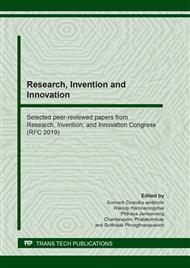[1]
B.R. Singh, O. Singh, Global Trends of Fossil Fuel Reserves and Climate Change in the 21st Century, Fossil Fuel and the Environment, InTech, Croatia and China. (2012).
DOI: 10.5772/38655
Google Scholar
[2]
A.S. Hossain, A. Salleh, A.N. Boyce, P. Chowdhury, M. Naqiuddin, Biodiesel fuel production from algae as renewable energy, Am. J. Biochem. Biotechnol. 4 (2008) 250-254.
DOI: 10.3844/ajbbsp.2008.250.254
Google Scholar
[3]
M.S. Kulkarni, P.G. Mirgal, P.P. Bodhale, S.N. Tande, Effect of rice husk ash on properties of concrete, Journal of Civil Engineering and Environmental Technology. 1 (2014) 26-29.
Google Scholar
[4]
R.V. Krishnarao, J. Subrahmanyam, T.J. Kumar, Studies on the formation of black particles in rice husk silica ash, J. Eur. Ceram. Soc. 21 (2001) 99-104.
DOI: 10.1016/s0955-2219(00)00170-9
Google Scholar
[5]
Information on http://infofile.pcd.go.th/mgt/Pollution%20Report%202016%20.pdf?CFID=143 6658 &CFTOKEN=27089274.
Google Scholar
[6]
S. Mustafi, M. Ahsan, A.H. Dewan, S. Ahmed, N. Khatun, N. Absar, Effect of waste glass powder on physico-mechanical properties of ceramic tiles, Bangladesh J. Sci. Res. 24 (2011) 169-180.
DOI: 10.3329/bjsr.v24i2.10775
Google Scholar
[7]
P. Chawakitchareon, P. Wongsaisuwan, S. Jiemsirilers, Effect of Temperature in Unglazed Ceramic Tile Production by replacement of Feldspar with Glass Cullet and Spent Silica-Alumina, Thai Environmental Engineering Journal. 32 (2018) 1-8.
Google Scholar
[8]
U. Wangrakdiskul, W. Loetchantharangkun, Utilizing Green Glass Cullet, Local Ball Clay and White Clay for Producing Light Greenish Brows Color Wall Tile, International Conference on Knowledge & Innovation in Engineering. 5 (2019) 39-47.
DOI: 10.33422/ejest.2019.08.14
Google Scholar
[9]
A.S. Ogunro, F. I. Apeh, O.C. Nwannenna, O. Ibhadode, Recycling Of Waste Glass As Aggregate For Clay Used In Ceramic Tile Production, American Journal of Engineering Research (AJER). 7 (2018) 272-278.
Google Scholar
[10]
Y.C. Khoo, I. Johari, Z.A. Ahmad, Influence of rice husk ash on the engineering properties of fired-clay brick, Adv. Mater. Res. 795 (2013) 14-18.
DOI: 10.4028/www.scientific.net/amr.795.14
Google Scholar
[11]
D. Eliche-Quesada, M.A. Felipe-Sesé, J.A. López-Pérez, A. Infantes-Molina, Characterization and evaluation of rice husk ash and wood ash in sustainable clay matrix bricks, Ceram. Int. 43 (2017) 463-475.
DOI: 10.1016/j.ceramint.2016.09.181
Google Scholar
[12]
L.D. Akwilapo, K. Wiik, Ceramic properties of Pugu kaolin clays. Part I: Porosity and modulus of rupture, B. Chem. Soc. Ethiopia. 17 (2003) 147-154.
DOI: 10.4314/bcse.v17i2.61661
Google Scholar
[13]
V. Kimambo, J. Yoeza, N. Philip, E. Hellen, Suitability of Tanzanian kaolin, quartz and feldspar as raw materials for the production of porcelain tiles, Int. J. Sci. Technol. 2 (2014) 201-209.
DOI: 10.11648/j.ijsts.20140206.17
Google Scholar
[14]
J. Parras, C. Sánchez-Jimeńez, M. Rodas, F.J. Luque, Ceramic applications of Middle Ordovician shales from central Spain, Appl. Clay. Sci. 11 (1996) 25-41.
DOI: 10.1016/0169-1317(96)00003-8
Google Scholar
[15]
S. Mishra, R. Mitra, M. Vijayakumar, Light weight silica tiles through foam casting method, J. Eur. Ceram. Soc. 28 (2008) 1769-1776.
DOI: 10.1016/j.jeurceramsoc.2007.12.030
Google Scholar
[16]
C. Kuenzel, L.M. Grover, L. Vandeperre, A.R. Boccaccini, C.R. Cheeseman, Production of nepheline/quartz ceramics from geopolymer mortars, J. Eur. Ceram. Soc. 33 (2013) 251-258.
DOI: 10.1016/j.jeurceramsoc.2012.08.022
Google Scholar
[17]
G.M. Azarov, E.V. Maiorova, M.A. Oborina, A.V. Belyakov, Wollastonite raw materials and their applications (a review), Glass and Ceramics. 52 (1995) 237-240.
DOI: 10.1007/bf00681090
Google Scholar


